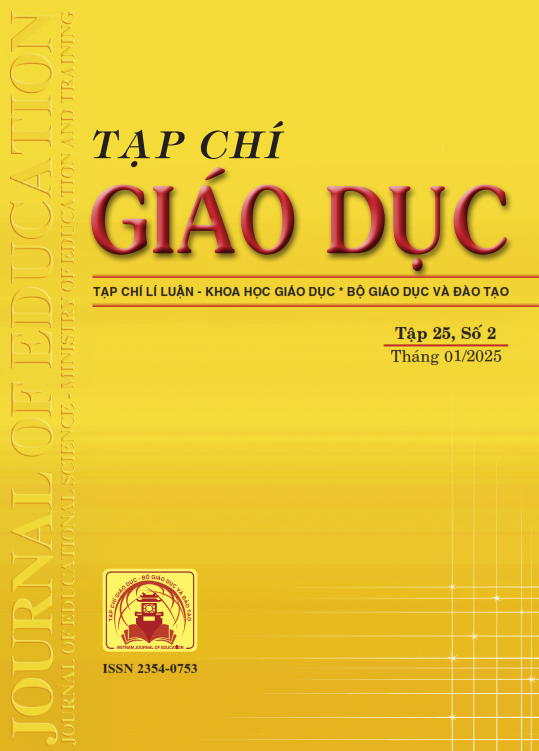Đặc điểm ngữ dụng xã hội của trẻ rối loạn phổ tự kỉ 4-5 tuổi và phát triển ngữ dụng xã hội cho trẻ trong môi trường hòa nhập
Tóm tắt
Social pragmatics refers to the ability to use language appropriately in various social situations, including understanding and adhering to social rules in communication. For children with autism spectrum disorder, developing social pragmatic skills is a challenging process that requires adequate intervention and support from teachers, families, and the surrounding environment. With the aim of helping these children develop social communication abilities and integrate socially effectively, this paper discusses the social pragmatic characteristics of 4 to 5-year-old children with autism spectrum disorder and the development of these skills in an inclusive environment. The research results clarify several issues related to the social pragmatic features of 4 to 5-year-old children with autism spectrum disorder and the factors affecting the development of these skills in an inclusive setting. Based on these findings, the study suggests activities to promote social pragmatic abilities in 4 to 5-year-old children with autism spectrum disorder in an inclusive learning environment, centered around the theme of “Family” to help them understand and use appropriate context in daily communication.
Tài liệu tham khảo
Baron-Cohen, S. (1997). Mindblindness: An essay on autism and theory of mind. MIT Press.
Frith, U. (2001). Mindblindness and the brain in autism. Neuron, 32(6), 969-979.
Gray, C. (1998). Social Stories™: Improving responses of students with autism with accurate social information. Focus on Autistic Behavior, 10(1), 1-10.
Grice, H. P. (1975). Logic and conversation. In P. Cole & J. L. Morgan (Eds.), Syntax and semantics: Vol. 3. Speech acts (pp. 41-58). Academic Press.
Guralnick, M. J. (2001). A framework for change in early childhood inclusion. In M. J. Guralnick (Ed.), Early childhood inclusion: Focus on change (pp. 3-38). Brookes.
Kaiser, A. P., & Hancock, T. B. (2003). Teaching communication skills to children with autism. Pediatric Clinics of North America, 50(4), 1017-1030.
Koegel, L. K., & Koegel, R. L. (1995). Teaching children with autism: Strategies for initiating positive interactions and improving learning opportunities. Brookes.
Koegel, R. L., & Koegel, L. K. (1987). The effects of self-management on the generalization of student academic behavior. Journal of Applied Behavior Analysis, 20(2), 161-169.
Landa, R. (2000). Social language use in children with language impairment. Topics in Language Disorders, 20(3), 15-30.
Loveland, K. A., & Tunali, B. (1991). Social scripts and dialogue in autism and typical development. Journal of Autism and Developmental Disorders, 21(2), 157-169.
Norbury, C. F. (2005). Barking up the wrong tree? Lexical ambiguity resolution in children with language impairments and autistic spectrum disorders. Journal of Experimental Child Psychology, 90(2), 142-171.
Odom, S. L., McConnell, S. R., & Brown, W. H. (2004). Social competence of young children with disabilities: Issues and strategies for intervention. Topics in Early Childhood Special Education, 24(1), 28-39.
Prutting, C. A., & Kirchner, D. M. (1987). A clinical appraisal of the pragmatic aspects of language. Journal of Speech and Hearing Disorders, 52(2), 105-119.
Rogers, S. J., & Pennington, B. F. (1991). A theoretical approach to the deficits in infantile autism. Development and Psychopathology, 3(2), 137-162.
Volkmar, F. R., & Klin, A. (2000). Diagnostic issues in Asperger syndrome. In A. Klin, F. R. Volkmar, & S. S. Sparrow (Eds.), Asperger syndrome (pp. 25-71). Guilford Press.
Vygotsky, L. S. (1978). Mind in society: The development of higher psychological processes. Harvard University Press.
Tải xuống
Đã Xuất bản
Cách trích dẫn
Số
Chuyên mục
Giấy phép

Tác phẩm này được cấp phép theo Ghi nhận tác giả của Creative Commons Giấy phép quốc tế 4.0 .












